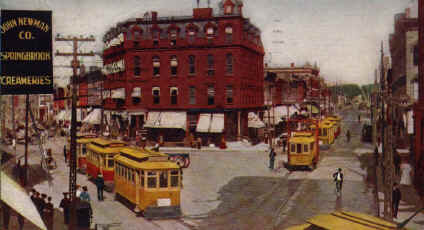|

|

|
|
Grove Ave.,
Douglas Ave. & Chicago Street Intersection |
When James
Gifford originally laid out Elgin, his intention was for Center Street, the area
above the often flooded lowland of the river, to be the hub of the city’s
business district. That area, however soon became popular for the city’s
vendors and stores began to spring up. In 1854, the city’s government was put
into place and the intersection of the four square mile area was the
intersection of East Chicago, Grove and Douglas Avenues. Farmers would bring
their produce and livestock to sell, and soon this area became known as Market
Square. Horses, however, need to be watered, so in 1873, a fountain was added
and the area became known as Fountain Square.
Elgin was
widely known for its dairies and butter production, and in 1898, The John Newman
Company opened their offices in Fountain Square. Newman owned or controlled
fifty two creameries, scattered throughout Northern Illinois, Eastern Iowa and
Southern Wisconsin. It was reported that over 55,000 cows were pastured on more
than 2,000 farms, which yielded over 500,000 quarts of Spring Brook Butter each
day.
While it is
uncertain when this card was printed, it certainly was before 1928, because the
large red building in this photo is gone. It was replaced by The Elgin
Tower (also known as The Home Bank Building). To learn more about Elgin's
progress and see that same corner 10 or 15 years later,
press here



| 